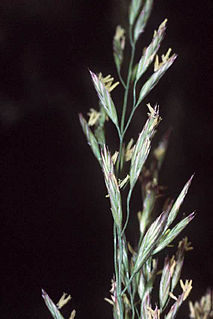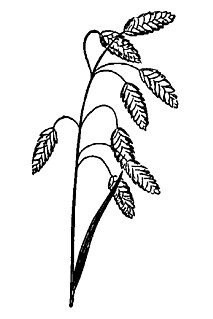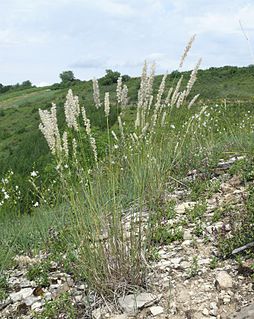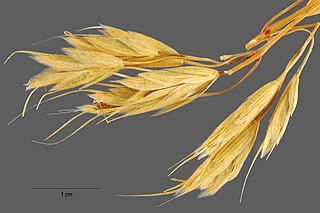
Festuca (fescue) is a genus of flowering plants belonging to the grass family Poaceae. They are evergreen or herbaceous perennial tufted grasses with a height range of 10–200 cm (4–79 in) and a cosmopolitan distribution, occurring on every continent except Antarctica. The genus is closely related to ryegrass (Lolium), and recent evidence from phylogenetic studies using DNA sequencing of plant mitochondrial DNA shows that the genus lacks monophyly. As a result, plant taxonomists have moved several species, including the forage grasses tall fescue and meadow fescue, from the genus Festuca into the genus Lolium, or alternatively into the segregate genus Schedonorus.

Bromus arvensis, the field brome, is a brome grass native to Europe and Asia. The specific epithet arvensis is Latin, meaning "of cultivated land".

Bromus hordeaceus, the soft brome, is an annual or biennial species of grass in the true grass family (Poaceae). It is also known in North America as bull grass, soft cheat, and soft chess.

Bromus secalinus is a species of bromegrass known as rye brome. The specific epithet secalinus is Latin, meaning "rye-like". The fruits are hard, rounded glumes that appear superficially similar to the rye grain, which gives the brome its common and scientific name. The grass has a diploid number of 28.

Bromus madritensis is a species of brome grass known by the common name compact brome. The specific epithet madritensis refers to Madrid, Spain. It has a diploid number of 28.

Bromus briziformis is a species of brome grass known by the common name rattlesnake brome. The specific epithet briziformis comes from the resemblance of the grass to grasses of the genus Briza, particularly Briza maxima. The common name is derived from the resemblance of the spikelets to the rattles of rattlesnakes. The grass has a diploid number of 14.

Bromus catharticus is a species of brome grass known by the common names rescuegrass, grazing brome, prairie grass, and Schrader's bromegrass. The specific epithet catharticus is Latin, meaning cathartic. The common name rescuegrass refers to the ability of the grass to provide forage after harsh droughts or severe winters. The grass has a diploid number of 42.

Bromus ciliatus is a species of brome grass known by the common name fringed brome. It is native to most of North America, including most of Canada, most of the United States except for some portions of the South, and northern Mexico. It is a plant of many habitats, including temperate coniferous forest. The specific epithet ciliatus is Latin for "ciliate", referring to the delicate hairs of the leaf blades.

Bromus kalmii, the Arctic brome or prairie brome, is a species of brome grass. It is a native bunchgrass in the North-central and Northeastern United States, the Great Lakes region, and eastern Canada. The specific epithet kalmii refers to its discoverer Pehr Kalm.

Melica ciliata, the hairy melic or silky spike melic, is a species of perennial bunchgrass native to Europe, north Africa, and temperate Asia. It has been introduced to South Australia.
Hopia obtusa is a species of grass commonly known as vine mesquite. This plant was treated as Panicum obtusum until recently when more molecular and genetic material revealed new information about it. Hopia obtusa is now placed in the monotypic genus Hopia.

Bromus erectus, commonly known as erect brome, upright brome or meadow brome, is a dense, course, tufted perennial grass. It can grow to 120 centimetres (47 in). Like many brome grasses the plant is hairy. The specific epithet erectus is Latin, meaning "erect". The diploid number of the grass is 56.

Oplismenus compositus, the running mountaingrass, is a species of perennial plant from the family Poaceae that can be found throughout Asia, Africa, Australia, South America, Mexico and Hawaii.
Melica argyrea is a species of grass found in Argentina, Brazil, and Uruguay.
Melica longiflora is a grass species in the family Poaceae that is endemic to Chile where it can be found from Coquimbo to Talca.
Melica mollis is a species of grass endemic to Chile where it grows in rock crevices at 340 metres (1,120 ft) above sea level.
Bromus latiglumis, the earlyleaf brome, is a grass native to North America. The specific epithet latiglumis is Latin for "broad-glumed", referring to the wide glumes.

Bromus japonicus, the Japanese brome, is an annual brome grass native to Eurasia. The grass has a diploid number of 14.

Bromus squarrosus, the rough brome, is a brome grass native to Russia and Europe. The specific epithet squarrosus is Latin, meaning "with spreading tips". The grass has a diploid number of 14.
Bromus pacificus, the Pacific brome, is a perennial grass native to the Pacific coast of North America. Bromus pacificus has a diploid number of 28.














